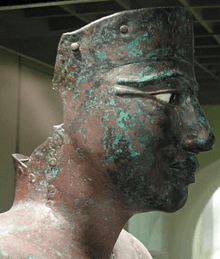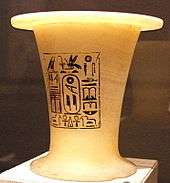Pepi I Meryre
| Pepi I Meryre | |||||||||||||||||||||||||||||||||||||||||||||||||||||||||||||||||||||||||||||||||||||||||||||||||||||||||
|---|---|---|---|---|---|---|---|---|---|---|---|---|---|---|---|---|---|---|---|---|---|---|---|---|---|---|---|---|---|---|---|---|---|---|---|---|---|---|---|---|---|---|---|---|---|---|---|---|---|---|---|---|---|---|---|---|---|---|---|---|---|---|---|---|---|---|---|---|---|---|---|---|---|---|---|---|---|---|---|---|---|---|---|---|---|---|---|---|---|---|---|---|---|---|---|---|---|---|---|---|---|---|---|---|---|
| Pepy, Phiops or Fiops | |||||||||||||||||||||||||||||||||||||||||||||||||||||||||||||||||||||||||||||||||||||||||||||||||||||||||
 Lifesize copper statue of Pepi I, Cairo Museum | |||||||||||||||||||||||||||||||||||||||||||||||||||||||||||||||||||||||||||||||||||||||||||||||||||||||||
| Pharaoh | |||||||||||||||||||||||||||||||||||||||||||||||||||||||||||||||||||||||||||||||||||||||||||||||||||||||||
| Reign | 2332–2287 BC (6th Dynasty) | ||||||||||||||||||||||||||||||||||||||||||||||||||||||||||||||||||||||||||||||||||||||||||||||||||||||||
| Predecessor | Userkare | ||||||||||||||||||||||||||||||||||||||||||||||||||||||||||||||||||||||||||||||||||||||||||||||||||||||||
| Successor | Merenre Nemtyemsaf I | ||||||||||||||||||||||||||||||||||||||||||||||||||||||||||||||||||||||||||||||||||||||||||||||||||||||||
| |||||||||||||||||||||||||||||||||||||||||||||||||||||||||||||||||||||||||||||||||||||||||||||||||||||||||
| Consort | Ankhesenpepi I, Ankhesenpepi II, Nubwenet, Meritites IV, Inenek-Inti, Mehaa, Nedjeftet | ||||||||||||||||||||||||||||||||||||||||||||||||||||||||||||||||||||||||||||||||||||||||||||||||||||||||
| Children | Nemtyemsaf, Pepi II, Hornetjerkhet, Tetiankh, Neith, Iput | ||||||||||||||||||||||||||||||||||||||||||||||||||||||||||||||||||||||||||||||||||||||||||||||||||||||||
| Died | 2287 BC | ||||||||||||||||||||||||||||||||||||||||||||||||||||||||||||||||||||||||||||||||||||||||||||||||||||||||
| Burial | Pyramid in South Saqqara | ||||||||||||||||||||||||||||||||||||||||||||||||||||||||||||||||||||||||||||||||||||||||||||||||||||||||
Pepi I Meryre (reigned 2332 – 2287 BC) was the third king of the Sixth dynasty of Egypt. His first throne name was Neferdjahor which the king later altered to Meryre meaning "beloved of Rê."[2]
Family
Pepi was the son of Teti and Iput, who may have been a daughter of Unas, the last pharaoh of the previous dynasty (V). He needed the support of powerful individuals in Upper Egypt in order to put down his brother, the usurper Userkare who had murdered his father and for Pepi to win back his rightful throne. These individuals would remain a strong presence in his court thereafter.
His two most important wives and the mothers of his two successors (Merenre Nemtyemsaf I and Pepi II) were Ankhesenpepi I and Ankhesenpepi II. Other known wives include Meritites IV, Nubwenet and Inenek-Inti, who are buried in pyramids adjacent to that of Pepi, Mehaa, who is named in the tomb of her son Hornetjerkhet, and a queen named Nedjeftet who is mentioned on relief fragments. He also had a son called Teti-ankh and two daughters, Iput II and Neith, both became wives to Pepi II.[3]
Reign

Pepi I's reign was marked by aggressive expansion into Nubia, the spread of trade to far-flung areas such as Lebanon and the Somalian coast, but also the growing power of the nobility. One of the king's officials named Weni fought in Asia on his behalf. Pepi's mortuary complex, Mennefer Pepy, eventually became the name for the entire city of Memphis after the 18th Dynasty.[4]
The decline of the Old Kingdom arguably began during Pepi I’s reign, with nomarchs (regional representatives of the king) becoming more powerful and exerting greater influence. Pepi I married two sisters – Ankhesenpepi I and II – who were the daughters of Khui, a noble from Abydos and Lady Nebet, made vizier of Upper Egypt.[5] Pepi later made their brother, Djau, a vizier as well. The two sisters' influence was extensive, with both sisters bearing sons who were later to become pharaohs.
Reign length

An analysis of the damaged Dynasty 6 South Saqqara Stone Annal document gives him a reign of c. 48–49 years but this is not confirmed by the Turin King List which apparently assigns him 44 years, according to the Danish Egyptologist Kim Ryholt's analysis of this document.[6] There has been some doubt regarding whether the cattle count dating system was strictly biennial or slightly more irregular. That the latter situation appeared to be the case was suggested by the famous Year after the 18th Count, 3rd Month of Shemu day 27 inscription from Wadi Hammamat No. 74-75 which mentions the "first occurrence of the Heb Sed" in that year for Pepi.[7] as well as a Year after the 18th Count, 4th Month of Shemu day 5 date in Sinai graffito No. 106 as the French Egyptologist Michel Baud noted in a 2006 book on Egyptian chronology.[8] This would be the year 36 if the biennial dating system was used. This information is significant because the Heb Sed Feast was always celebrated in a king's Year 30. If Pepi I was using a biennial counting system during his reign, these heb sed inscriptions should have been dated to the Year after the 15th Count instead. This could imply that the cattle count during the 6th dynasty was not regularly biennial. Michel Baud, however, stresses that the Year of the 18th count is preserved in the South Saqqara Stone and writes that:

- "Between the mention of count 18 [here] and the next memorial formula which belongs to count 19, end of register D, the available space for count 18+ is the expected half of the average size of a theoretical [year count] compartment. It is hard to believe that such a narrow space corresponds to the jubilee celebration, which obviously had a considerable importance for this (and every) king."[10]
Baud notes that there was a tendency during this ruler's administration to mention the first jubilee repeatedly in the years following its celebration—in connection with intense building activity at the king's funerary complex until even to the end of Pepi I's reign when this pharaoh's highest date—the Year of the 25th Count, 1st Month of Akhet day [lost]--from Hatnub Inscription No.3.[11] appears; this ruler's final 25th count is also strikingly associated with Pepi I's first royal jubilee.[10] The South Saqqara Stone confirms that Pepi I's last year was his Year of the 25th Count.
Therefore, the references to Pepi I's first jubilee being celebrated in his 18th cattle count are likely just part of this royal tendency to emphasize the king's first jubilee years after it was first celebrated and Michel Baud (and F. Raffaele) both note that the longest year compartment in the South Saqqara Stone appears "at the beginning of register D. Fortuituously or not, this [year] compartment corresponds perfectly to year 30/31, if a strictly biennial system of numbering is presumed" for Pepi I's reign.[10] (i.e. his 15th count) Therefore, the count was mostly likely biennial during Pepi I's reign and the reference to his final year—the 25 count—implies that he reigned for 49 full years.
An artifact bearing Pepi's name found in a layer of a temple at Ebla, Syria destroyed in the 23rd century BC became one of the primary strengths for synchronizing the dates of the entire Old Kingdom of Egypt, however it has been pointed out that this evidence is weaker than desired, as it was found with a cache of artifacts from earlier pharaohs as well, which may all easily have been centuries old antiques by the time they reached Ebla.[12]
Monuments

Two copper statues of Pepi I and his son Merenre were found at Hierakonpolis; they are thought to depict the two royals symbolically "trampling underfoot the Nine bows," a stylized representation of Egypt's conquered foreign subjects.[4] These rare statues were found in one of the underground stores of the temple of Nekhen "together with a statue of king Khasekhemwy (Second Dynasty) and a terracota lion cub made during the Thinite era."[13] The statues had been disassembled and placed inside one another and sealed with a thin layer of engraved copper bearing the titles and names of Pepi I "on the first day of the Jubilee" or Heb Sed feast.[14] While the identity of the larger adult figure as Pepi I is revealed by the inscription, the identity of the smaller and younger statue remains unresolved.[14] The most common hypothesis among Egyptologists is that the athletic young man in the smaller statue was Merenre
- "[he] who was publicly associated as his father's successor on the occasion of the Jubilee. The placement of his copper effigy inside that of his father would therefore reflect the continuity of the royal succession and the passage of the royal sceptre from father to son before the death of the pharaoh could cause a dynastic split."[15]
More recently, however, it has been suggested that the smaller statue is in fact that "of a more youthful Pepy I, reinvigorated by the celebration of the Jubilee ceremonies."[16]
Pepi I was a prolific builder who ordered extensive construction projects in Upper Egypt at Dendera, Abydos, Elephantine and Hierakonpolis. One of his most important court officials was Weni the Elder who had a great canal built at the First Cataract for the king. Weni was singly responsible for hearing an unusual charge against a Queen Weret-yamtes, a resident in Pepi’s harem. Weni gives no further information on this event.[17]
See also
References
| Wikimedia Commons has media related to Pepi I. |
- ↑ VIth Dynasty
- ↑ Nicolas Grimal, A History of Ancient Egypt, (Blackwell Books: 1992), p.84
- ↑ Aidan Dodson & Dyan Hilton, The Complete Royal Families of Ancient Egypt, Thames & Hudson (2004) ISBN 0-500-05128-3, pp.72-72
- 1 2 Grimal, p.84
- ↑ Kanawati,p173
- ↑ Kim SB Ryholt, 'The Turin King-List' in The Political Situation in Egypt during the Second Intermediate Period, CNI Publications, (Museum Tusculanum Press: 1997), pp.13-14
- ↑ Anthony Spalinger, Dated Texts of the Old Kingdom, SAK 21: 1994, p.303
- ↑ Michel Baud, The Relative Chronology of Dynasties 6 and 8 in Erik Hornung, Rolf Krauss & David Warburton (editors), Ancient Egyptian Chronology (Handbook of Oriental Studies), Brill, 2006., p.148
- ↑ Nigel C. Strudwick, Ronald J. Leprohon: Texts from the Pyramid Age, ISBN 9004130489.
- 1 2 3 Baud, p.150
- ↑ Spalinger, p.304
- ↑ Michael C. Astour, Eblaitica 4, p. 60.
- ↑ Alessandro Bongioanni & Maria Croce (ed.), The Treasures of Ancient Egypt: From the Egyptian Museum in Cairo, Universe Publishing, a division of Ruzzoli Publications Inc., 2001. p.84
- 1 2 Bongioanni & Croce, p.84
- ↑ Bongioanni & Croce, pp.84-85
- ↑ Bongioanni & Croce, p.85
- ↑ Grimal, p.83
